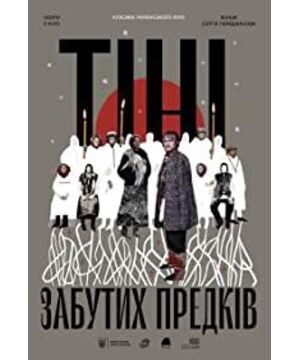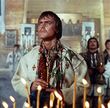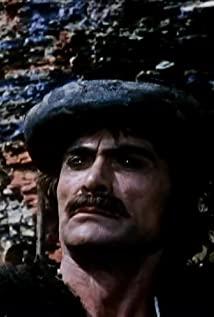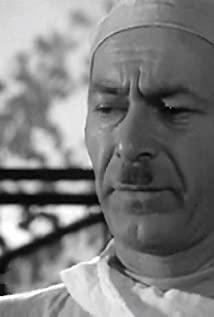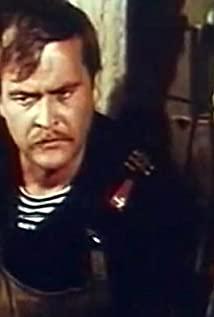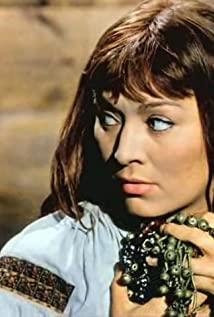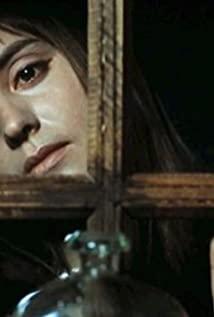This film is one of the representative works of poetic films by the famous Ukrainian contemporary director Sergei Barrajanov (1924-1990). It is now difficult to imagine what kind of "nervous shock" and "strong interest" this film once aroused in the Soviet film industry. As soon as the film came out, it caused a sensation both inside and outside the Soviet Union, but the reviews of the Soviet film industry were mixed. One opinion is that the film is formalism and artistic abstraction, and that the film is too far from the original. Another opinion believes that "The Shadow of the Forgotten Ancestor" faithfully conveys the spirit of the original work and conforms to the hidden connotation of the original work, and believes that the film is an impulse of the Ukrainian poetic film school following Duvrenke's first few films. It explores a particular form of practice for Ukrainian national cinema. There are also comments that Kotyubinski's original work is only a source of inspiration for the director, while Balajanov has successfully demonstrated historical memory in this film with a unique poetic film style, showing the expression of national subconsciousness, The possibility of the river of life expressing the survival and development of the nation.
The film has little in common with traditional cinema in conception, structure, and poetics. The film's image system is unusual and often surprising. The director's modeling treatment emphasizes painting and metaphor, so every shot of the film can be the object of study. In an interview with reporters in 1966, Balajanov said, "I have always loved painting, and I have long been accustomed to treating the camera as an independent painting. I know that my directorial art will happily integrate into painting. I think , perhaps this is its first weakness, but also its first strength. In my own practice, I most often use painting-style processing, rather than literary-style treatment, only the literature that is essentially a deformation of painting , is what I can achieve. Therefore, it can be said that the film is essentially different from Mikhail Kotyubinsky's novel, although the novel is the basis of the script." It cannot be said that Balajanov emphasizes the work here. However, it should be pointed out that the modeling treatment of each picture in "The Shadow of the Forgotten Ancestor" is unique. The director's intention is not to record a movement, but to express a thought, a meaning, a A stereoscopic effect. The passion of the picture shown by the lens is not stagnant, but dynamic. On the one hand, they are as lifelike as snapshots, on the other hand, they are full of changing, multi-pointed meanings. Balaranov used Ukrainian national cultural metaphors, myths, symbols and other rich modeling methods to screen out the colorful costumes, banquets, weddings, celebrations, prayers, etc. in the mysterious world of the ancient Guchurs from folklore. Dip them in the bloody river of time, and arrange the pictures, so as to mobilize the power of symbols and reveal their special relationship with the world being reproduced.
Funeral rites are the dominant theme of the film. Barrajanov begins the film's narrative with the funeral of a Balichuk and runs it throughout the film. Dusk, dead trees, a funeral process. The funeral procession disappeared into the vast snow field, and a black cross stood on a high hill. This black cross is constantly hidden in various sets of shots, outlining the lives of the protagonists. The black cross flashes on the window case against the horizon, then becomes a black shadow on the floor; it casts on the hide hanging on the torture instrument, and then appears again in the carnival at the end... just In this way, the stories of life and death of the forgotten ancestors jumped out from the pictures outlined by black crosses, and complemented the slowly changing interior scenes, costumes and faces, forming a rich and beautiful Ukrainian folk customs. 's picture scroll. Some of the costume ceremonies in the film were invented by Barrajanov. Part of the ritual in the story "Ivan and Barragona" is Barrajanov's imagination. However, many Gu Chu people who acted as extras on the filming site did not raise any objection, because the director's creation was quite consistent with the whole ceremony. It can be seen that Balaranov has dissolved his uncontrollable imagination in nature.
The series of metaphorical symbols that make up the plot in this film reflects the director's special aesthetic ability. With his extraordinary metaphors, stunning shapes, and delicate and persistent depictions of ancient customs, Balaranov calls for the worship of beauty. For example, the little lamb of the angel, it is white, then black; it is a symbol of life, and it is a symbol of death. Also, when Ivan lost Marischka, the beautiful colors of nature faded, and the sky and the earth dissolved in a vast gray.
Calling the characters in the film "character" or "personality" is not necessarily appropriate. In this film, there is an unusual appearance of a shape symbol that cannot be called "image" that has never been seen in traditional films. The characters of Ivan, Marischka, Balaguena, and Yurko in the film are, in their essence, meaningless. Each of them is just a shape symbol for someone. Just like the characters in mythology, they are only the embodiment of a certain will of God, not related to their own circumstances and changes. So, while the cast of Shadow of the Forgotten Ancestors are great, they have little to offer. What the actors perform is only the ritualistic movements of the archetypes of destiny, betrayal, death, etc. in a love tragedy. They help the director squeeze the literary rhythm out of the film, help the audience to perceive the flow of the plot and determine some primitive questions: when, where, who, how, what, why, and so on.
In terms of its plastic deformation play structure and unique poetic style, the anti-literary tendency of this film is obvious, but the film does not completely get rid of the basic plot of the original work, and the director also fails to poetically combine literary thinking with film thinking. connected into a harmonious whole. However, if you watch this film and the subsequent creations "The Color of Pomegranates" and "The Legend of Suramskaya Castle" in one go, it is possible to have the feeling that in these three films of Barrajanov The same theme runs through the masterpieces, and it continues with symbols, metaphors, and associations, and this continuity is naturally and powerfully expressed by the same modeling code.
In The Color of a Pomegranate, Barrajanov's cinematic poetics is most harmoniously and dazzlingly revealed. The film is based on the life story of the famous Armenian poet Sayat-Nova. The director seeks answers to the pressing questions of human survival and development and the highest value of the human spirit in the lives, arts and legends of Georgia, Armenia, and Azerbaijan. There is little dialogue, no monologue, just a voiceover of Sayat-Nova's poetry throughout. In a general sense, there are no protagonists in the film, only certain symbols and symbols. This is the story of a poet's soul. Sayat-Nova in the film is sometimes an old monk, sometimes a little boy. Sometimes the child and the old monk appear in the same shot, while the parents of the long-dead poet suddenly appear in the frame. The poet also appears at the same time as the Empress Anna, whom he loved in his youth, in white and black. Then came the rushing river, the cut off sheep's head, a book and a live fish, and a white cloth with three blood-red pomegranates painted on it. The audience seems to vaguely feel that the director has given all this a certain kind of profound meaning. Although the picture is beautiful, the meaning is not very clear. Barrajanov said of "The Color of Pomegranates": "We tell the times and people, their passions and ideas through hypothetical, extraordinary and exact language of things. The works of folk artists. , clothing, carpets, decorations, furnishings in the house - these are the elements of the language of things. These elements form the material aspect of the era."
"The Legend of Suramskaya Castle" continues the style of "Shadow of Forgotten Ancestors" and "The Color of Pomegranates". Incoherent plots, jerky fictions, numerous associations, metaphors, symbols, myths are harmoniously intertwined, sourceless and endless. In the dialogue between Christian culture and Islamic culture, the film divides the legend of Dumirsh Khan into several small stories to narrate, and gives each story a title: "Tbilisi South Gate", "Dream and Death". hunch”, etc. Before each story, the director arranged a beautiful picture as an inscription: "Sketch of the Newborn Baby and the Little Lamb", "The Newborn Baby and the Oil Lamp", "The Newborn Baby and the Gold Coin"... This film tells the story of Doerr Mish Khan's parting from his lover, his wandering in a foreign land, his son's return to his homeland and his sacrifice at the Suramskaya Castle for the independence of his homeland. The long-standing historical legend of the Georgian nation has become the aesthetic origin for the director to think about the beauty of national culture and national spirit.
Some critics believe that Balaranov set off an "aesthetic revolution" in the history of Soviet cinema with "Shadows of Forgotten Ancestors". Not to mention the success or failure of this "revolution", it should be admitted that these three masterpieces of Balajanov have special aesthetic value, and the director's practice in them can be regarded as a special "quarrying". Work. He split the shape of the traditional Soviet film and the "granite" of the play, divided it into aesthetic monosubs, divided them into poetic primitives, and then constructed his own poetics. Barrajanov's cinematic poetics is not an art of constructing itself out of natural entities. Instead, he started his quest for art from the national culture, and did everything possible to push this quest to the foreground, using it as a banner and a challenge.
In these three masterpieces, Balajanov completely abandoned the conventions of traditional cinema, so it is difficult to make a general analysis of his "plot mosaic" and "color kaleidoscope" of vivid film material. However, if the audience does not deliberately look for a linear plot development in his works, but can dissolve into the poetic rhythm of the director's infatuation with nature, and together with the director, feel the beauty of the surrounding world with the innocent heart of a child, and feel the beauty of life. Joys, sorrows, life and death, then the numerous symbols, metaphors and associations in the film, as well as those beautiful inscription paintings, may become the guide for the audience and the director to ascend together in their spiritual journey, thus helping the audience to understand Barrajanov's understanding of film poetics.
View more about Shadows of Forgotten Ancestors reviews


